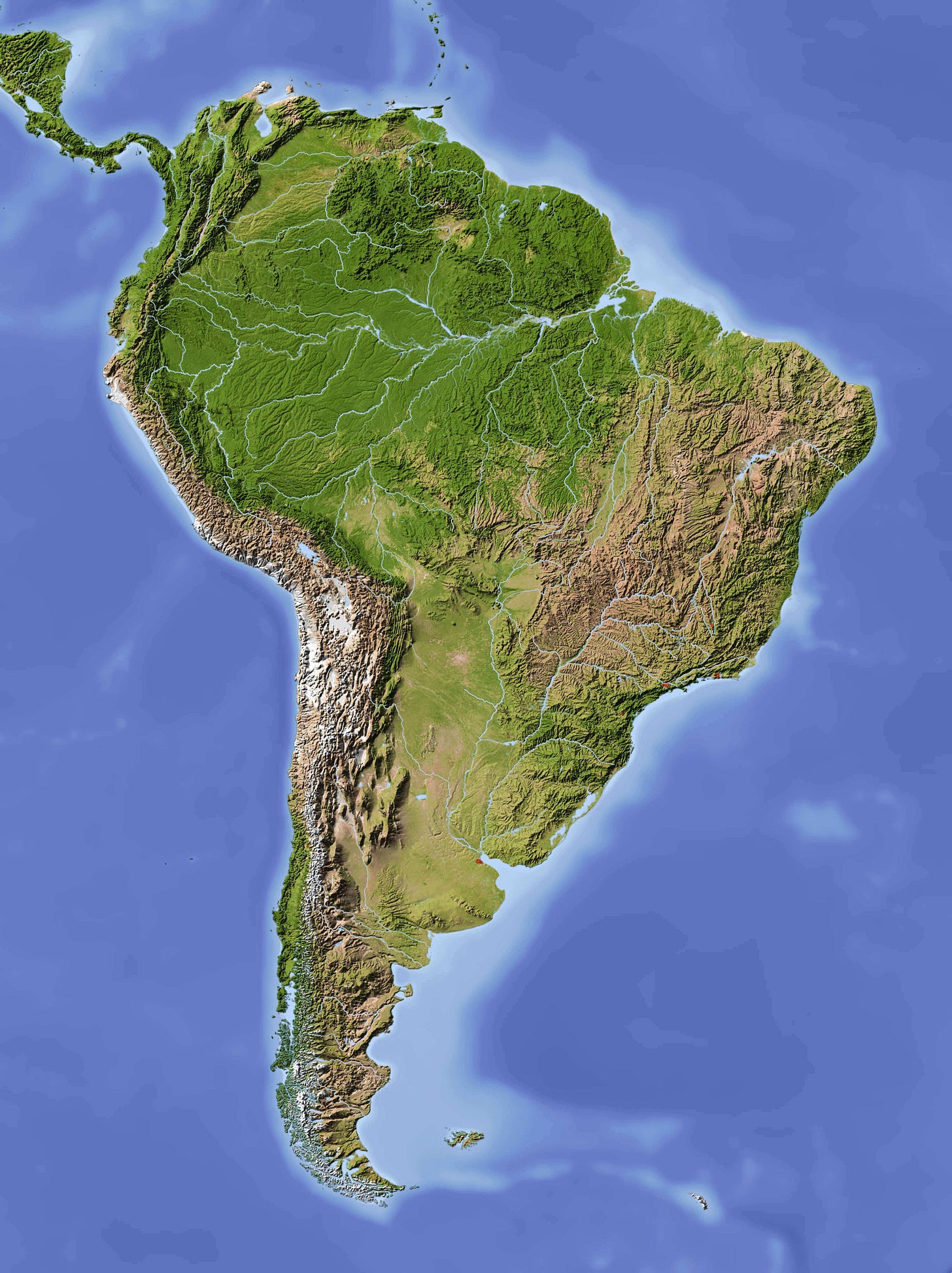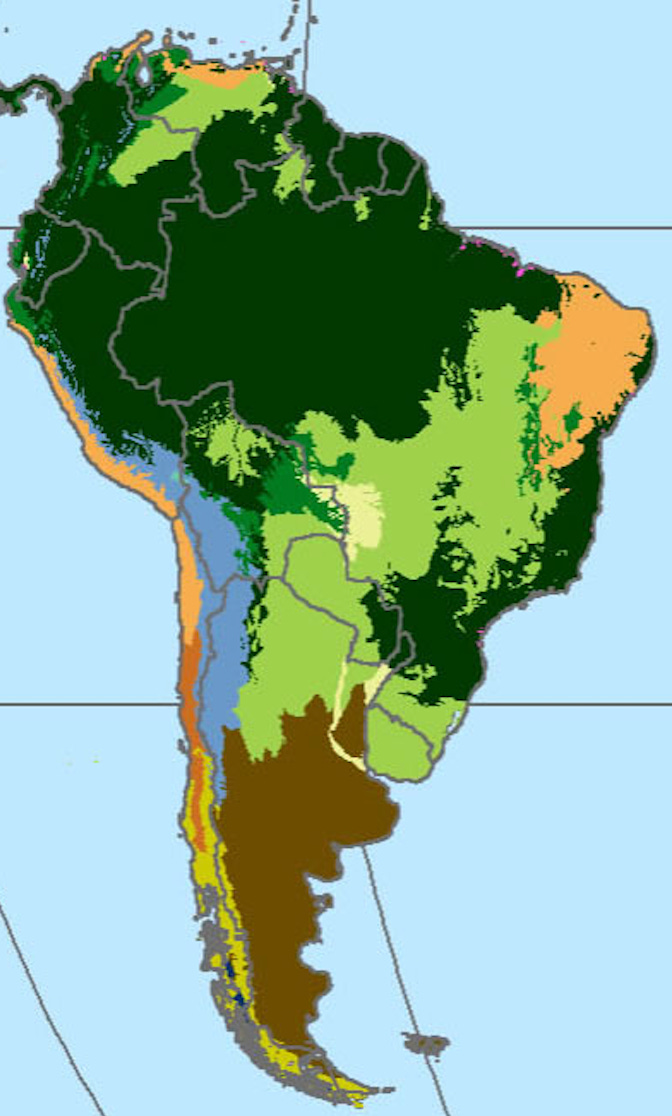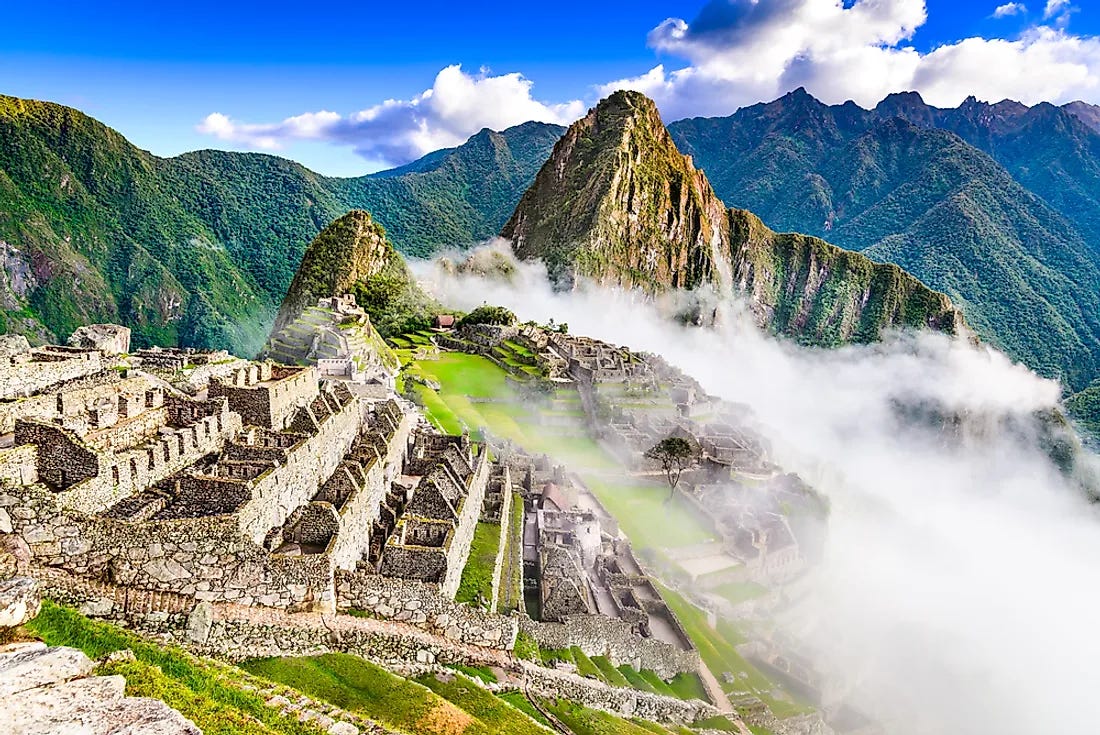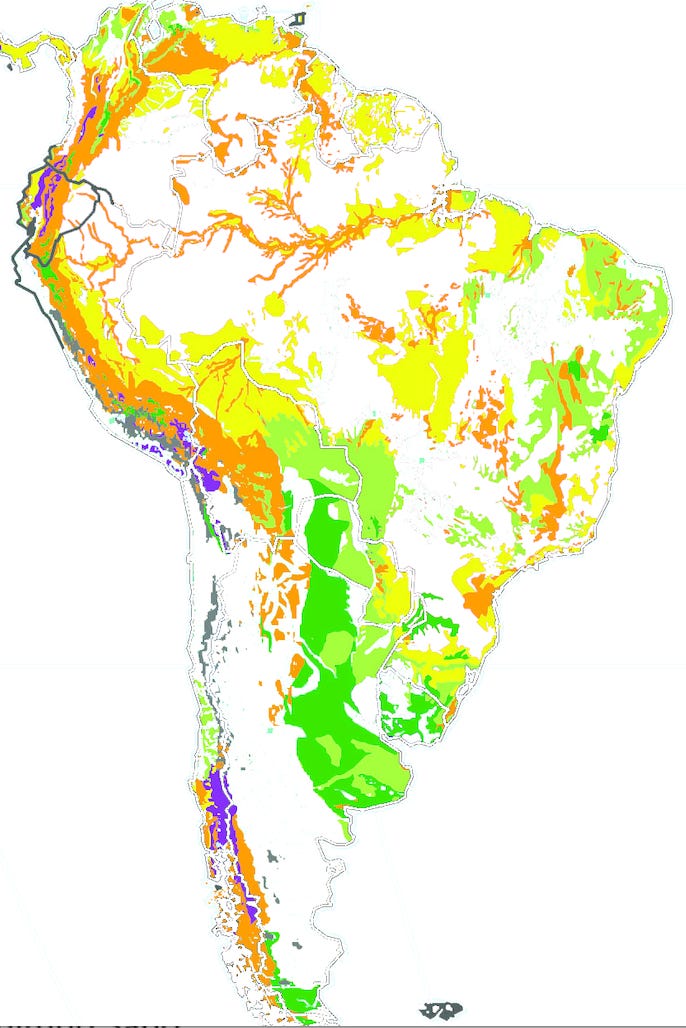How geography shaped South American development
Make someone’s day: Gift a subscription to your friends and family!
A major focus of my book series and this Substack column is the geographical foundations of modern progress. In particular, I am interested in geographical factors that enabled complex societies to evolve. In this article, I will focus on South America.
By complex societies, I mean:
Agrarian societies (who acquired their food calories from plow-based agriculture)
Commercial societies (who invented progress)
Industrial societies (which most of us live in today)
First of all, let me be clear.
Geography does not create human material progress. Geography is a constraint on human material progress, but some regions have fewer constraints than others. Those lucky regions were able to develop far more complex societies than the rest of the world. Eventually, this led to a significantly higher material standard of living for the masses.
The critical historical sequence of Society Types that we are looking for is:
Hunter-Gatherer society (which is the starting point for human societies in every region) >
Horticultural society (agriculture with hand tools) >
Agrarian society (agriculture with animal-traction plows) >
Commercial society, which invented material progress >
Industrial Revolution, which expanded existing material progress.
Geography plays a massive constraint on each of these stages, so most regions have a hard cap on the level of complexity of human societies that can evolve without assistance from outside. The Industrial Revolution and the American-backed global free trade order established after World War II made this assistance possible.
You can get a quick overview of how I believe that geography constrains Society Types in this graphic:
Much of this post is an excerpt from my book From Poverty to Progress: Understanding Humanity’s Greatest Achievement. You can order my e-books and audiobooks at a discounted price at my website, or you can purchase full-price ebooks, audiobooks, paperback, or hardcovers on Amazon.
Other books in my “From Poverty to Progress” book series:
Other articles about how geography has influenced economic development by region:
Why are there such huge variations in income across the globe?
How geography constrained progress (intro to this series)
Biomes
The single most important factor in whether a region enables complex societies to evolve is its biome. A biome is a category for a geographical area based on its dominant vegetation. The dominant vegetation in any area sets very broad constraints on what type of plants and animals can evolve there. The dominant vegetation sustains the local herbivores, which then sustain the local carnivores. Since humans use a portion of these plants and animals as base materials for food production, biomes play a critical role in constraining the types of human societies that can develop within them.
Plow-based agriculture, a necessary transition step to modern progress, is only possible at a distance from river basins in a few biomes:
Temperate Forest biomes
Mediterranean biomes
(after the invention of the steel plow in the 1830s) Temperate Grassland biomes.
Unfortunately for South America, Temperate Forests and Mediterranean biomes are restricted to modern-day Chile which is very small in land area and isolated from the rest of the continent by the towering Andes mountain. The grasslands of the Argentine Pampas were significantly bigger, but without steel plows, it was virtually impossible to cultivate using traditional agricultural technologies.
This did not mean that agriculture was absent from pre-Columbian South America. One of the most complex societies that never invented animal-drawn plows flourished in the valleys of the Andean mountains. This civilization culminated in the Inca Empire. Relatively simple Horticulture was also widely practiced in the Amazon rainforests. While they were very complex compared to Hunter Gatherer societies, they were nothing compared to the civilizations of Eurasia.
Soil
Even with the proper biomes, a region needs fertile soil for agriculture. Because agriculture is key to feeding dense human populations, the type of soil in a region is critical to its ability to support complex societies. Soil is the combination of:
weathered rock,
air,
water, and
organic matter from decomposing plants and animals.
At least somewhat productive soil is fairly widely distributed throughout South America, but it is mainly concentrated along the Andes mountain chain in the west. The most productive soil that does not require steel plows, Andisols, is relatively rare.
Rivers
Most large and prosperous cities are located on rivers or natural ocean ports. Rivers offer crucial advantages to human development. Rivers:
Offer sources of (hopefully) clean drinking water.
Make it easier to remove human waste.
Offer sources of irrigation for crops.
Deposit additional nutrients in the soil for growing crops.
Enable cost-effective transportation of people and freight.
Offer defensible lines to block the approach of enemy armies.
South America has a large number of easily navigable rivers, including the massive Amazon river system, Parana, and Orinoco. The problem is that, except for the lower reaches of the Parana river, none of them flow through biomes that are suitable for plow-driven agriculture. The Amazon and Orinoco flow through the Tropical Rain Forests. For this reason, very few of the most important cities in South America are located on a river bank in strong contrast to cities in Europe, Asia, and North America.
Altitude
Except for Highlands in Tropical latitudes, complex societies are concentrated on the plains at altitudes of 500 meters or lower. While landmass on Earth varies in altitude from just below sea level to 10,000 meters above, about 73.7 percent of humanity inhabits altitudes of less than 500 meters above sea level.
Because South America is largely in Tropical latitudes, its flat terrain is actually a disadvantage. The most hospitable regions for human habitation are in the plateaus and valleys of the Andes mountains. Significant population densities in other regions did not occur until well after the Spanish/Portuguese conquest and European migration.
Growing Season
Unfortunately, I have not been able to find any data on the length of Growing Seasons in South America.
Wild ancestors of domesticated animals and plants
Most of the factors that enable productive agriculture are pure geography, but biogeography also plays an important role. Productive agriculture requires domesticated animals and domesticated plants. In particular, a region needs:
Animals that provide a reliable source of protein and fatty acids: cows, pigs, goats, sheep, or chickens.
Animals that are capable of pulling plows: horses, cows, or water buffalo
Staple crops that provide dense sources of carbohydrates, such as rice, wheat, corn, or potatoes.
Before a society can domesticate a plant or animal, the wild ancestors of those plants and animals need to be either:
located in the region or
close enough that human migration can bring those domesticated animals into the region.
Both North and South America were missing one key ingredient for the evolution of complex societies: a lack of the native wild ancestors of domesticatable animals. South America had alpacas, llamas, guinea pigs, but no horses, cows, pigs, goats, or sheep. Alpacas and llamas were used for meat, hide, wool, and their dung was used for fuel, but as far as I know, there is no evidence of either species successfully pulling a plow. The steep terrain that dominated the Andes might also played a role in the inability to invent animal-driven plows.
Traditional Andean farmers cultivated potatoes using foot plows (raucanas). This dramatically lowered the food surplus compared to Agrarian societies that used animal-driven plows in Eurasia. Of course, it is impossible to prove, but I think that this lack of animal-driven plows put a hard cap on the level of complexity that pre-Columbian societies in South America could have evolved into. The Agrarian societies that dominated the Eurasian continent could simply not evolve within the geographical constraints of South America.
Fortunately for the human societies in the Andes, the wild ancestors of potatoes were easy to cultivate and store, so this staple crop provided a very nutritious diet year-round. The main disadvantage of potatoes is that they are heavy and difficult to transport, particularly without animal-drawn wagons or carts.
More than 4,000 varieties (!) of native potatoes grow in the Andean highlands of Peru, Bolivia, and Ecuador. Just as Western Civilization was based on wheat, oats, and rye, and Eastern civilizations were based on rice, the Andean Civilization was based on potatoes.
The threat of Herding societies
Unlike the Agrarian societies of Eurasia, South American societies were never threatened by aggressive Herding societies. With a lack of the native wild ancestors of horses, cows, pigs, sheep, and goats, this society type was simply not possible. This significantly lowered the military threat to South American societies.
Interestingly, the introduction of Spanish horses to the Argentine Pampas transformed the Tehuelche people from Hunter Gatherers to horse-riding Herding societies. A very similar societal transition occurred in the North American Great Plains, showing how the introduction of key technologies and domesticated animals can completely transform societies very quickly.
If the horse had been native to South America, it is not difficult to imagine the Tehuelche horse archers striking terror throughout the region as Mongol warriors did throughout Eurasia.
Geographical Isolation
Societies often develop by copying technologies, skills, and social organizations from other societies. And military conquest by other societies can seriously set back long-term development. Because of those two facts, neighboring societies have a major impact on societal development.
The most important such constraint was proximity to the Middle East. As we have seen, agriculture evolved in the Fertile Crescent (modern-day Syria, Iraq, and Southern Turkey). Early Agrarian societies in Egypt, Mesopotamia, and Anatolia played an important role early in the Agrarian era. These regions played a critical role because they had many wild ancestors of domesticated plants and animals.
Obviously, South America was extremely isolated from the rest of the world by the Atlantic and Pacific oceans. It was even isolated from North America by the very narrow isthmus of Panama. This meant that even the relatively complex Andean societies were unable to adopt technologies and practices from other agricultural societies.
This combined with less productive agricultural techniques created a massive gulf in the level of technologies relative to Eurasian Agrarian empires. Once European empires invented sailing ships capable of crossing oceans, this isolation came to a sudden and tragic end. Their world came crashing down with the sudden arrival of Spanish conquistadors and Spanish diseases in 1528.
Conclusion
All of the above put far stronger geographical constraints on the potential development of South America than in Europe and Asian. While agriculture evolved, these geographical constraints made complex Agrarian and Commercial societies impossible. Nor could South America have ever experienced an Industrial Revolution on its own. It was only when the continent came into contact with European empires that it could potentially evolve beyond those stages.
As with the vast majority of Horticultural societies, South America has had a very difficult time industrializing and competing on the world marketplace. The region has not been able to establish many competitive export industries outside of raw materials, foodstuff, and petroleum.
South America can roughly be divided into three big regions. Each region has very different histories and levels of contemporary development due to their geographical constraints:
The Amazon and Orinoco river rain forests, where relatively simple Horticultural regions evolved. This region could not have evolved past this point due to geographical constraints, and it is still relatively sparsely populated.
The Andean Highlands, where potato-based Horticulture enabled much higher population densities and more complex societies. While this region easily had the most complex societies before 1500, the lack of domesticated animals pulling plows and wagons made it extremely unlikely that they could evolve into complex Agrarian or Commercial societies. This guaranteed them to remain trapped in pre-Industrial poverty without outside assistance.
The Spanish conquered these regions, but the population was and still is dominated by indigenous culture and genes. The Spanish conquerors established a small elite that dominated a far larger and poorer indigenous population. The nations that descended from their Horticultural ancestors have had trouble escaping that legacy.A Temperate region in Chile, Argentina, Uruguay, and southern Brazil that was very sparsely populated before the Spanish conquest for geographical reasons, but then experienced massive immigration from Spain and Italy in the 19th and early 20th Centuries. With the exception of petroleum-rich Venezuelan before the Hugo Chavez, all the wealthiest nations within South America are located in this region. While not as wealthy as Western nations, their material standard of living more closely approximates Eastern Europe than the rest of South America.
This region is dominated culturally and genetically by Europeans.
Just as the British and French did in North America, the Spanish and Italians terraformed the region culturally, technologically, and genetically.
The difference is that while much of British North America was settled by people from Commercial societies, this region was settled by people from Agrarian societies. They each set up societies that strongly resembled their homeland.
I plan to write a separate article on this topic later, so I will end it here.
Much of this post is an excerpt from my book From Poverty to Progress: Understanding Humanity’s Greatest Achievement. You can order my e-books and audiobooks at a discounted price at my website, or you can purchase full-price ebooks, audiobooks, paperback, or hardcovers on Amazon.
Other books in my “From Poverty to Progress” book series:
Other articles about how geography has influenced economic development by region:
Why are there such huge variations in income across the globe?
How geography constrained progress (intro to this series)
Some other great Substack columns on geography that you should subscribe to:
















